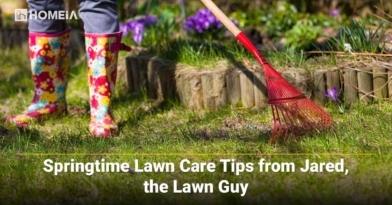Top 12 Tips for Eco-Friendly Gardening Year-Round
- Author:by The HOMEiA Team
- Category: Home Improvement

Gardening is not just a hobby – it is a way of life. For many, tending to plants and watching them grow is therapeutic. But as we become more environmentally conscious, there’s a growing need to ensure our gardening practices are sustainable. Eco-friendly gardening is the future, and with a few simple steps, you can make your garden not only green, but green!
Table of Contents:
- 1. Let’s Start with Your Lawn
- 2. Water Consumption: A Thirsty Lawn
- 3. Chemical Runoff: The Hidden Danger
- 4. Biodiversity Loss: A Monoculture Desert
- 5. Mowing: Seriously?
- 6. From Green to Green
- 7. Understanding the Basics of Eco-Friendly Gardening
- 8. Choosing the Right Plants for Every Season
- 9. Natural Pest Control: Friend or Foe?
- 10. Water Conservation: Every Drop Counts
- 11. Composting: Turning Waste into Wealth
- 12. Garden Design: Planning for Sustainability
- Bonus: Community Gardening: Growing Together
1. Let’s Start with Your Lawn
A lush green lawn is often seen as a symbol of landscaping and gardening success. However, its environmental implications are significant.
2. Water Consumption: A Thirsty Lawn
Green lawns, especially in unsupportive regions, consume vast amounts of water. This excessive usage can deplete local water resources, affecting both humans and ecosystems. In water-scarce areas, using water for lawns can be wasteful.
3. Chemical Runoff: The Hidden Danger
Many homeowners use fertilizers, pesticides and herbicides for lawn maintenance. These chemicals, when washed away by rain, can harm aquatic life and contaminate groundwater.
4. Biodiversity Loss: A Monoculture Desert
Manicured lawns support only one type of plant, leading to a lack of biodiversity. This monoculture doesn’t provide the varied food sources and habitats that local wildlife needs.
5. Mowing: Seriously?
This one sells itself, because honestly, who actually wants to mow their lawn?
6. From Green to Green
For the remainder of this article, we are going to explore alternative ways to not only make your landscaping not only look great, but also be ecologically sustainable. We’ll focus on eco-friendly gardening and explore tips and tricks for every season and every aspect of this exciting movement in landscape maintenance.
7. Understanding the Basics of Eco-Friendly Gardening
Eco-friendly gardening is about more than just planting trees and flowers. It is about creating a balanced ecosystem in your yard. This means using natural methods to fertilize, control pests and conserve water. It’s a holistic approach that benefits not only your garden but the environment as a whole.
Private Water Wells Can Increase Property Value and Decrease Monthly Costs
Water wells can bring forth nostalgic visions of a simple life where one fetched a bucket of water at the pump. While wells have a place in the imagination, they also have a place in the modern world. Simply put, a well is a private water source that can serve as an alternative to a municipal…
8. Choosing the Right Plants for Every Season
Gardening in harmony with the seasons is the cornerstone of eco-friendly practices. By selecting plants that naturally thrive during specific times of the year, gardeners can reduce the need for artificial interventions, conserve water and ensure a vibrant garden year-round. Here’s a deeper dive into the best plants for each season:
Spring Blooms
- Wildflowers: Choose those native to your region. Wildflowers like bluebonnets, primroses and violets are adapted to local climates and soils. They provide a burst of color after the winter months and serve as early sources of nectar for pollinators.
- Bulbs: Tulips, daffodils and hyacinths are spring staples. Planting them in the fall ensures a radiant garden come spring.
- Fruit Trees: Early spring is when many fruit trees, such as apple, cherry and plum, blossom. Their fragrant flowers are not only visually appealing but also attract beneficial insects.
Summer Greens
- Succulents: Plants like aloe, agave and echeveria store water in their leaves, making them perfect for hot, dry summers.
- Native Grasses: Switchgrass, bluestem and fescue are resilient to heat and can add texture and movement to your garden.
- Herbs: Many herbs, including basil, rosemary and thyme, thrive in the summer heat. They’re not only useful for culinary purposes but also have aromatic properties that can deter pests.
Autumn Hues
- Deciduous Trees: Maple, oak and birch trees showcase a riot of colors in the fall. Their dropping leaves also provide natural mulch for the garden.
- Perennials: Plants like chrysanthemums, asters and goldenrod bloom in the cooler autumn months, adding color and attracting late-season pollinators.
- Berries: Shrubs like holly, viburnum and beautyberry produce vibrant berries in the fall, providing food for birds and adding visual interest.
Winter Wonders
- Evergreens: Pine, spruce and cedar trees remain green throughout the winter, providing color and shelter for birds.
- Hellebores: Also known as Christmas roses, these flowers can bloom even in the snow, offering a hint of spring in the heart of winter.
- Winter Jasmine: This hardy shrub produces bright yellow flowers in the coldest months, bringing cheer to an otherwise dormant garden.
By carefully selecting plants that are naturally attuned to the rhythms of each season, gardeners can create a sustainable, eco-friendly garden that is alive and thriving throughout the year.
Springtime Lawn Care Tips from Jared, the Lawn Guy
Raking is a messy chore but this simple investment of time and effort is one of the best things you can do for a healthy and beautiful lawn. Simply put: the lawn can breathe easier and access rain, fertilizer and air without any old thatch suffocating the lawn’s root system…
9. Natural Pest Control: Friend or Foe?
Pesticides can harm the environment. Instead, introduce beneficial insects like ladybugs and praying mantises to your garden. They’re natural predators to common pests.
Beyond the Basics
While introducing beneficial insects is a great start, nature has its own abilities to attract and deter insects:
- Companion planting: This age-old practice involves pairing plants that benefit each other. For example, basil planted near tomatoes can repel flies and mosquitoes. Similarly, nasturtiums planted near broccoli can deter aphids.
- Biological controls: Introducing natural predators, such as nematodes for slug control or braconid wasps for tomato hornworms, can keep pest populations in check without the use of chemicals.
- Plant diversity: A diverse garden attracts a variety of insects, ensuring no single pest dominates. Mixing plants can also confuse pests, making it harder for them to find their preferred host.
How-to Lawn Care in the Summer, by the Lawn Guy Jared
Summer’s heat, wind, and sporadic rain are tough on a lawn, but this article will hopefully give you some simple tips on how to improve your green-space…
10. Water Conservation: Every Drop Counts
Overwatering is a common mistake. Not only does it waste water, but it also makes plants more susceptible to diseases. To make watering simpler and more efficient, use a rain barrel to collect rainwater and use it for watering. Drip irrigation systems are also more efficient than traditional sprinklers, ensuring water reaches the roots directly.
Advanced Techniques
Water is a precious resource, and its conservation is paramount in sustainable gardening.
- Rain gardens: These are designed to capture runoff, allowing rainwater to seep into the ground. Plants in rain gardens should be chosen for their ability to tolerate both wet and dry conditions.
- Soil amendments: Adding organic matter to the soil can improve its water retention capacity. Compost, worm castings and well-rotted manure can make a significant difference.
- Watering techniques: Watering early in the morning or late in the evening reduces evaporation. Also, watering deeply and less frequently encourages roots to grow deeper, making plants more drought resistant.
10 Ways to Add Greenery to your Living Room
Big or small, on their own or in groups, plants are a great way to bring nature into your home. Here we’ve gathered ten fresh, creative ideas for bringing greenery into your living room…
11. Composting: Turning Waste into Wealth
Kitchen scraps, yard waste and even paper can be turned into nutrient-rich compost. Compost enhances soil quality, reduces the need for chemical fertilizers and recycles organic waste. A well-maintained compost pile can produce ready-to-use compost in as little as two months.
The Science and Art
Composting is more than just piling up kitchen and garden waste. It’s a science that, when done right, can transform waste into black gold.
- Types of composting: From traditional bin composting to worm composting (vermicomposting) and bokashi, each method has its benefits and is suited to different types of waste and garden sizes.
- Balancing greens and browns: For efficient composting, it’s essential to balance nitrogen-rich green materials, like vegetable scraps, with carbon-rich brown materials, like dried leaves.
- Aeration and moisture: Regularly turning the compost pile introduces air, which aids decomposition. The pile should be moist like a wrung-out sponge for optimal microbial activity.
Mulching: Protect and Preserve
Mulch acts as a protective layer for your garden. It conserves moisture, suppresses weeds and improves soil health.
More Than Just a Protective Layer
Mulch does wonders for the garden, but choosing the right type and applying it correctly is key.
- Types of mulch: From organic mulches like straw and wood chips to inorganic ones like gravel and landscape fabric, each type has its benefits and applications.
- Benefits of mulching: Beyond moisture conservation and weed suppression, mulch can regulate soil temperature, prevent erosion and, over time, improve soil structure and fertility.
- Application tips: It’s essential to apply a thick enough layer (about 2-4 inches) but avoid piling mulch against plant stems to prevent rot.
The Best 10 Ways to Maintain Your House
Your house is most likely the most expensive purchase of your lifetime — and a safe haven that provides a hub for everyday activities, relaxation and making memories. It doesn’t remain in great shape without some effort, but with some loving care and an organized maintenance schedule, you can manage the upkeep without added stress…
12. Garden Design: Planning for Sustainability
A well-designed garden can reduce maintenance efforts and increase sustainability. Planting trees on the western side of your property can provide afternoon shade, reducing cooling costs. Similarly, creating a rain garden can help manage stormwater runoff, preventing soil erosion.
Embracing Technology
The fusion of technology and gardening can lead to remarkable results.
- Garden planning apps: These tools can help you design your garden by taking into account plant spacing, growth patterns and companion planting guidelines.
- Weather tracking: Modern weather apps and sensors can predict rainfall, helping you adjust your watering schedule accordingly.
- Plant identification apps: Snap a photo, and these apps can identify plants, giving you care instructions and potential pest problems to watch out for.
Bonus: Community Gardening: Growing Together
Joining or starting a community garden can amplify the benefits of eco-friendly gardening. Sharing resources, knowledge and produce can foster a sense of community and promote sustainable practices on a larger scale. If your community doesn’t have enough help, you can call a landscape company; they often use landscape maintenance solution software to keep track and make sure your community’s landscape stay in top shape.
In Conclusion
Eco-friendly gardening is a journey, not a destination. Every small step you take toward sustainability can have a significant impact on the environment. By adopting these practices, you’re not only nurturing your garden but also contributing to a greener planet. Remember, the future of our planet lies in our hands, and every garden, no matter how small, can make a big difference.
10 Productive Activities You Can Do at Home to Stay Healthy
We all know the value of a healthy lifestyle, but in today’s fast-paced world, fitting wellness activities into the day can be a challenge. There’re plenty of opportunities throughout the day to improve your health and wellness while getting things done. Here’re the top 10 productive activities you…
























